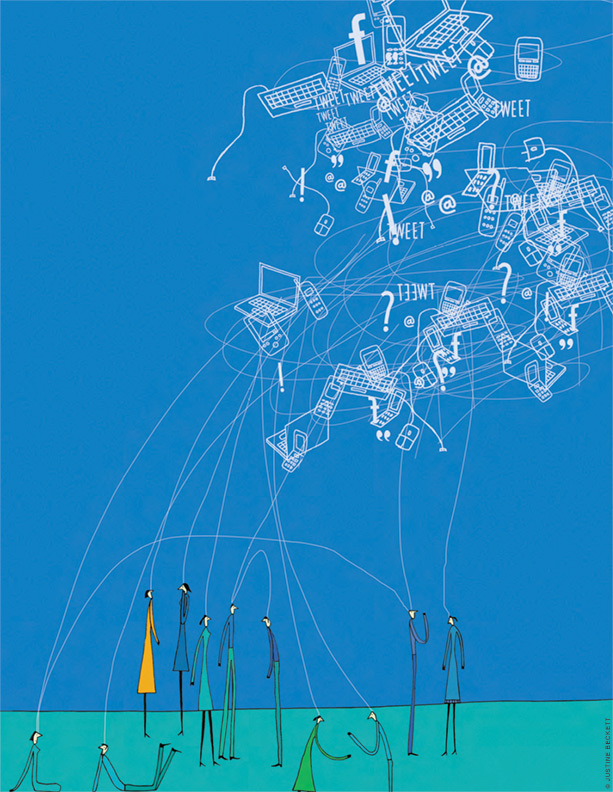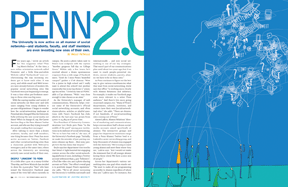
The University is now active on all manner of social networks—and students, faculty, and staff members are even inventing new ones of their own.
By Molly Petrilla
Illustration by Justine Beckett

Five years ago, I wrote an article for this magazine titled “Fine ’09 Meets Online.” At the time, a new online orientation network called Pennster and a little blue-and-white Website called “thefacebook” were revolutionizing the way incoming students got to know each other. It was 2005, and while email and Web browsers were already fixtures of modern life, popular social networking sites like Facebook were just beginning to emerge. It was a time when pre-freshmen meeting on those sites was big news.
With the soaring number and variety of social networks out there now—and with users ranging from young children to 90-year-old grandmas—I began to wonder how the social-networking landscape at Penn had also changed: Was the University fully utilizing the new social media out there? Who’s in charge of, say, the Career Services blog or the Penn Alumni Twitter account, and who are they trying to reach? Are people reading their messages?
After talking to more than a dozen students, faculty, and staff members, one thing became clear: Penn has more active accounts on Twitter, Facebook and other social-networking sites than a classroom packed with Web-savvy teenagers; and at the same time, others across the University are inventing entirely new social media of their own.
Deeply “LinkedIn” to Penn
It’s a little after 1 p.m. on a sunny October Thursday, and Steve Minicola has decided to show the 15,000-plus “fans” who have joined the University’s Facebook page some of the vivid fall colors currently on campus. He posts a photo taken next to Penn’s Love sculpture with the caption “Another gorgeous fall day on College Green.” Within only a few hours, he’s received almost a dozen spontaneous responses from a wide range of Facebook users. “Gosh do I miss Penn’s beautiful campus!” gushes a C’08 alumna. “Wow I’m a junior in high school and I really want to attend this school!! Just another reason why this is my top choice :),” a teenage boy writes. “I loved my time at PENN,” adds a C’90 alumnus. “Wish I was close enough to take classes as an alum.”
As the University’s manager of web communications, Minicola helps oversee some of the University’s official social networking accounts, and often shares photos, articles, or playful questions with Penn’s Facebook fan club, which in the last year has grown from 5,000 to 15,784 as of press time.
Vice President of University Communications Lori Doyle puts Penn “in the middle of the pack” among peer institutions in its embrace of social networking. “We try to have fun with it,” she says, of the University’s Facebook page. “Initially, we made the mistake of just putting our news releases up there … [but now,] people love the fun items that we post.”
Doyle says her department tries to echo that blend of light-hearted-but-engaging content across the other social-networking platforms it uses, including a Twitter account with more than 4,300 “followers”; a YouTube video site; and a photo-sharing account on Flickr. “Our office’s overall goal is to positively impact Penn’s reputation,” she adds. “We’re all about increasing the University’s visibility nationally and internationally … and now social networking is one of our key strategies. That wasn’t part of our communications plan until about two years ago, but if we want to reach people—potential students, current students, parents, alumni—we have to be on these sites.”
As Penn continues to figure out the best way to give various constituencies what they want from social networking, Doyle says her office “is working more closely with Alumni Relations and Athletics, for example, to make our Facebook page even more relevant to a wider Penn audience.” And there’s lots more going on around campus, too. “Many of Penn’s departments, schools, institutes, and centers have their own [social-networking] sites,” she adds. “There are dozens, if not hundreds, of social-networking sites coming out of Penn.”
Aimee LaBrie, Alumni Relations’ director of marketing and communications, helps oversee about half a dozen social-media accounts aimed specifically at alumni. The interactive groups and pages her department maintains range from a Penn Alumni Twitter feed to a LinkedIn career-networking group, and help thousands of alumni stay engaged with the University. “We’re trying to reach young alumni and meet them where they are,” LaBrie says. “But I would not make the statement that it’s all younger alumni [using these sites]. We have a nice mix of people.”
Across her department’s various networking sites, one goal often stands out: “We want to make all our programming accessible to alumni regardless of where they are,” LaBrie says. For instance, this past fall, when the University hosted an alumni conference on diversity and community, Penn Spectrum [“Gazetteer,” Sept|Oct], some 1,600 followers of the Penn Alumni Twitter account were able to follow along at home through a steady stream of “live-tweets” that included highlights from key speeches and up-to-the-minute photos. More recently, videos from the event have been posted on YouTube.
Aside from keeping up with events and general University news, Penn uses social networks to disseminate valuable career-oriented information. Alumni Relations and Career Services co-manage the University of Pennsylvania Alumni group on LinkedIn, which is 13,500-plus members strong. According to its managers, the site is meant for “career networking and professional development purposes,” and to that end, group members can post 200-character “discussion” messages, along with information about jobs and promotions.
Keeping track of LinkedIn and the other social media sites that career services oversees is the responsibility of Shannon Kelly, job and internship coordinator/social media guru. “We recognized that these platforms were growing, and we wanted to make sure that we were utilizing all these technologies to stay relevant and stay connected,” she says. “We also try to make sure there’s something for everyone.” To that end, Career Services created an official Facebook account in July 2008, followed in 2009 by a Twitter feed, the LinkedIn group, a video site, and a blog titled Penn & Beyond.
“Our blog is one of the best features of our office and one of our best uses of social media,” Kelly says. “We have a staff of about 28, and everyone contributes to the blog.” In the year since its inception, blog entries have ranged from tips for a successful interview to working abroad as a potential career advancer.
Kelly also posts links, announcements, and other tweet-sized bits to the Career Services Twitter page—usually at least two tweets per hour, she says. Those tweets join the thousands of other social-networking messages coming out of Penn daily, from students, departments, schools, and organizations: There’s the Kelly Writers House Twitter and podcasts; the “Penn on iTunes” account; the Penn Alumni Travel Facebook page; Wharton’s Twitter, Flickr, YouTube, and LinkedIn accounts. The list goes on and on.
And then there are the students. “Social networks are a way of life,” says Jay Rodrigues, a senior in Wharton who knows quite a bit about the topic. (More on that later). “They’re a huge aspect of what we do and how we communicate, and that’s not going away.”
While many Penn students use these sites simply to keep in touch with their friends or goof around—both crucial components of the social-networking experience—some student groups have found them invaluable in communicating with their fans and constituents. The Hindi student a capella group Penn Masala has just over 5,000 Facebook fans, and uses its account to announce tour dates, share video and song recordings, and answer fans’ questions. The student-run Social Planning and Events Committee has an active Twitter feed and Facebook page, and The Daily Pennsylvanianeditors tweet highlights from each issue to more than 2,000 followers.
And just as I first wrote in the fall of 2005, today’s incoming students are still using social networks to meet and discuss campus life online before ever arriving at Penn. If you have any doubt, just look at the “Official UPenn Class of 2014 Group” on Facebook, with more than 2,100 members.
Pennster, the University’s exclusive online orientation network created in 2004, is also still going strong—and it’s just one of the specialized social networks that have been invented at Penn.
The New Frontier of Social Networks
This past October, The Chronicle of Higher Education detailed a new trend among universities: In light of successful sites like Twitter and Facebook, certain schools, “are turning to social networking to create online learning communities that mix serious academic work, and connections among working scholars, with Facebook-style fun.” One example of this new “social learning” wave is the College of Liberal & Professional Studies’ Open Learning Commons, launched at the beginning of 2009.
While LPS has offered online-only courses for years, the Learning Commons takes the experience a step further, providing students from around the world access to supplemental blogs, discussion forums, a Twitter-like “chatter wall,” ask-the-expert forums, and the opportunity to create individual social profiles and send each other private messages. “[Our program] is focused primarily on working adults who don’t, for the most part, study full-time or live on campus,” says LPS vice dean and executive director Nora Lewis. “Often, they aren’t as connected to the University as they would like to be, and as we would like them to be. We really want our students to use the Commons to build closer community among themselves, but the unique thing here is that the social-networking aspects are all part of the overall learning experience.” In short, it’s about adding the social side you’d have in a classroom to online learning.
Since its debut, the Commons has hosted more than 2,000 students and 44 online courses. The platform also includes areas for specialized communities, such as the Urban Women’s Health Collaborative, the Post-Baccalaureate Pre-Health Community, and the Neuroethics Open Educational Resource.
As other schools begin to implement similar social learning forums—Going on Networks, which helped develop Penn’s learning commons, is also working with Berkeley, Columbia, and Virginia State University—Lewis says she plans for LPS’s platform to grow, with more online courses in the works for this summer.
The Organized Networker
Around the time that LPS higher-ups were cultivating their idea for an online learning platform, Jay Rodrigues W’11—then a rising sophomore at Penn—was raising funds and beginning beta testing for his own vision of social networking. As a high school senior, Rodrigues envisioned a social network open only to college students (what some might call, “Facebook in the good old days”). Once he arrived at Penn, that idea began to transform, he says: “I got involved in a lot of groups, and attended a lot of events that other groups hosted. I was constantly finding out about events that were taking place that I hadn’t heard about, and I found I was missing things. That’s where [my] website took its first directional shift; we built a heavy calendar component into the social-networking framework to try to solve the problem I was experiencing as a student at Penn.”
Starting with that shift, Rodrigues’ original idea transformed into DormNoise, an interactive calendar system for busy college students like him. With about a million dollars in financing, Rodrigues created a company that partners with institutions to offer students a set of campus, group, and personal calendars that sync with smartphones and popular programs like iCal and Google Calendar. “Our goal is to allow busy students at all levels to organize their different events and activities,” Rodrigues says. The company also emphasizes “a social aspect to calendaring,” allowing students to RSVP for events they plan to attend, view who else is attending a given event, create a “friends” list, and keep tabs on which events those friends are attending. “We use the word ‘interactive’ to describe our calendars,” Rodrigues adds, “but you could just as easily substitute the word ‘social.’”
The company serves about 25,000 students, faculty, and administrators who are spread across 30 campuses, including Bay State College, Newbury College, and Bryant & Stratton College. Rodrigues says there are also about 900,000 students “in our pipeline,” meaning their respective schools are currently reviewing contracts with DormNoise. As the company’s founder and CEO, Rodrigues typically works 60- to 80-hour weeks, attending classes in the morning, putting in a solid eight-hour DormNoise workday from noon to 8 p.m., then cracking his schoolbooks back open to complete homework assignments or study for exams. “It’s a tough balance,” he says, “but I’m really good at managing my time. I am, after all, a calendar guy.”
Ready for Take-Off
Imagine that you’re a Penn student with an idea—a great idea, if you do say so yourself. You’ve dreamed up a new website that will revolutionize the way people use the Internet—or at least capture their ever-shrinking attention spans for a few minutes. There’s just one problem: You don’t have any funding yet, and you know nothing about coding a website. (You’re a business major, after all, not a computer-science person.) You realize there are students out there who would jump at the chance to help; you just don’t know how to find them.
If you’re resourceful, after a bit of poking around, you might stumble upon PennLaunch, a Web-based networking tool for the Penn community that helps idea-people find others to help them. “It’s still a social network, but it’s one based around ideas versus the Facebook interactions of ‘Do you want to get dinner together?’” explains Anne Stamer, director of the Weiss Tech House, which created PennLaunch. “The goal here is to enable individuals and groups to easily connect with each other.”
The searchable database requires a PennKey to log in, and is open to students, staff, faculty, and alumni. “Anyone with an idea or project is welcome,” Stamer adds, “as well as anyone with special skills they want to offer.” Listed projects—which can include both independent pursuits and class assignments—provide a basic description (for example, “a Web-based service offering simple collaborative video for casual users”) and the stage they currently embody (from “Just an Idea” and “Prototyping” to “Profitable” and “IPO”). Users are also encouraged to list their skills to allow those with projects to search for them.
The website launched in March 2010 after two years in the making, and so far more than 600 people have signed up as registered users. “We plan to continue growing this,” Stamer says. “The purpose of this is to be open to everyone, and to me, that’s the most exciting component, because everyone has a skill that can be utilized.”
A Beautiful Day in the i-Neighborhood
How well do you really know your neighbors? It’s a question that’s fueled plenty of Dateline specials, but for assistant professor Keith Hampton, it’s led to something more serious: a six-year Annenberg School for Communication research project that’s engaged about 86,000 people across the United States and Canada. Billed as the place “where neighbors come to meet, plan, and stay informed,” i-Neighbors is a free Web-based resource through which users can find their real-life neighbors online and form digital communities.
Registered users can share photos, links or files, post about upcoming events, and participate in discussions. “Most of the discussion that takes place is about very mundane local issues,” says Hampton. But there’s something below those surface exchanges, he adds: real connections. Often, digital i-Neighbor exchanges lead to offline friendships.
“I think there’s a fundamental misconception about how people form and maintain relationships online,” he says. “Most people think of the Internet as a global village, but what we’ve found is that the opposite tends to be true: It connects people at great distances, but it also connects people very locally and facilitates community involvement.”
As for Penn’s social-networking neighborhood, you might say it’s grown from a one-horse town into a thriving metropolis in the last five years. With all that’s out there now and that continues to develop in Penn’s social networks, there’s no excuse not to connect with whatever parts of the University interest you most. (Not sure how to get started or create an account? Just ask the nearest 12-year-old.)
Stay tuned to your local Internet connection to see which networks the University hops on—or creates—next, and maybe you’ll even hear from me again after the next generation of social networking has come into focus. In the meantime, go ahead: Tweet your heart out.
Molly Petrilla C’06 writes regularly for the Gazette and oversees its arts & culture blog.




